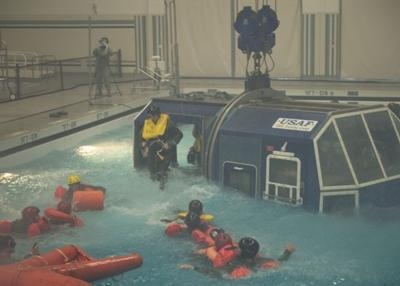Four Trained For Upcoming Missions On CST-100, Crew Dragon Missions
Four NASA astronauts trained with U.S. Air Force Survival School instructors in water survival and recovery Feb. 10, at the base fitness center pool at Fairchild Air Force Base in Washington state. The astronauts underwent the training in preparation for anticipated test flights of the new commercially made American rockets, the Boeing CST-100 Starliner and the SpaceX Dragon.

“It’s a different space program now,” said Sunita Williams, a NASA astronaut. “We’re flying in capsules instead of shuttles, and they can land anywhere. You never know when an emergency situation may happen, so we’re grateful to get this training.”
The astronauts were put through the paces of bailing out from a simulated crash landing in water. They learned to deploy and secure a life raft, rescue endangered crewmembers, avoid hostile forces and experience being hoisted into a rescue vehicle. “This is the first time we’ve gotten a complete environmental training experience, lots of wind, waves and rain,” said Doug Hurley, a NASA astronaut. “This is a great way to experience how bad it can get and how important it is to be prepared.”
The astronauts opted to join in with more than 20 water survival course students, despite being given the option to train alone. “They didn’t want to train on their own,” said Lt. Col. Chas Tacheny, the chief of NASA Human Space Flight Support-Houston. “They wanted to train with the group because some of these people may one day be preforming search and rescue for them.”
Other NASA astronauts visited the survival school last year in an effort to research and test the viability of its training course and facilities. The astronauts liked what they experienced and NASA has since developed its training partnership with the schoolhouse. “The SERE instructors are advising us in water recovery,” Behnken said. “These experts are the most experienced I’ve ever seen. They are able to spot holes in our training and fill the gaps.”

NASA’s Neutral Buoyancy Laboratory in Houston possesses a large water training facility built to simulate weightless conditions during space walks, but it’s not properly equipped to simulate water surface conditions for recovery training.
This training is vital for future NASA mission recovery operations, said Behnken. We are working with the experts here to eventually replicate the survival school water survival training equipment at the NBL facility in Houston. “I’m impressed by the use of the facilities here,” Williams said. “It’s a small space, but they really manage to simulate all kinds of weather conditions and situations we might experience during a water landing.”
The survival school originally had a separate detachment at the Naval Air Station Pensacola, Florida, where it conducted water survival training in open ocean waters. The training was brought to Fairchild Air Force Base in August 2015 in an effort to save time and money by consolidating training at one location. “It was a good decision for the Air Force to streamline our training efforts by moving all portions of water survival training here,” said Col. John Groves, the 336th Training Group commander. “However, the fitness center pool was designed for recreational use and isn’t suited to the ever increasing demands placed on it by our training programs. Bottom line, we owe it to our Airmen and mission partners such as NASA, who rely on our unique training capabilities, to have a purpose built water survival training facility.”
(Images provided with USAF news release)
 ANN's Daily Aero-Term (04.25.24): Airport Rotating Beacon
ANN's Daily Aero-Term (04.25.24): Airport Rotating Beacon ANN's Daily Aero-Linx (04.25.24)
ANN's Daily Aero-Linx (04.25.24) Klyde Morris (04.22.24)
Klyde Morris (04.22.24) Airborne 04.24.24: INTEGRAL E, Elixir USA, M700 RVSM
Airborne 04.24.24: INTEGRAL E, Elixir USA, M700 RVSM Airborne 04.22.24: Rotor X Worsens, Airport Fees 4 FNB?, USMC Drone Pilot
Airborne 04.22.24: Rotor X Worsens, Airport Fees 4 FNB?, USMC Drone Pilot




